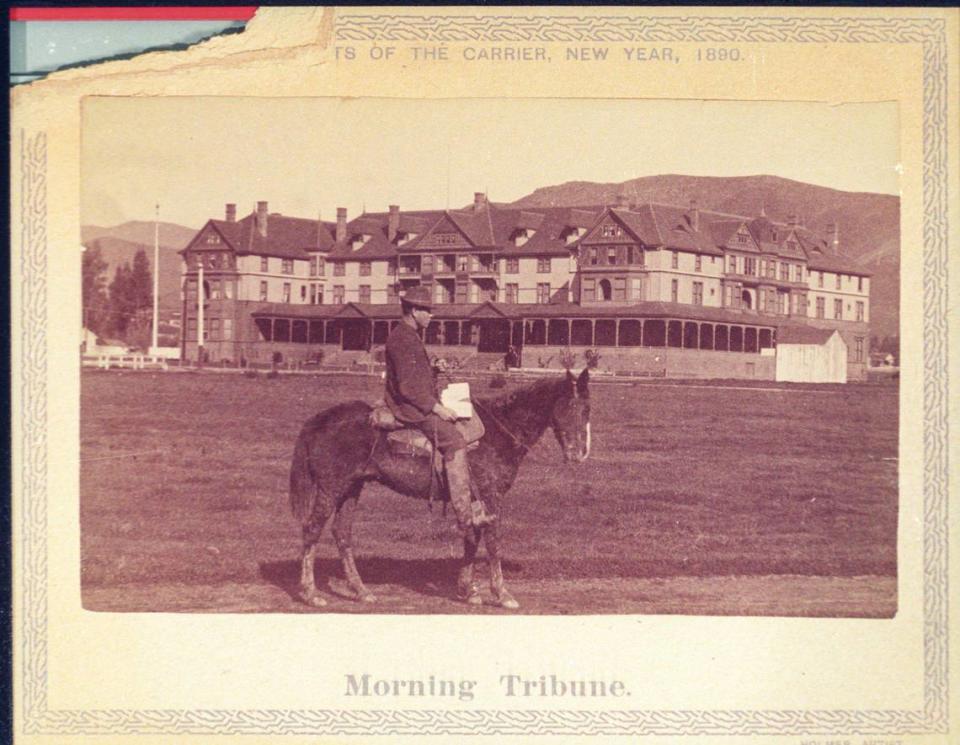Carriers once delivered The Tribune on horseback. Here’s how paper reaches subscribers now
The Tribune transitioned this week to mail delivery for the print version of the newspaper.
In some ways, it is a return to an earlier time when the weekly paper was delivered by the U.S. Mail to rural customers.
When the Tribune was founded in August 1869, it was hand printed in Walter Murray’s adobe across the street from Mission San Luis Obispo de Tolosa in downtown San Luis Obispo. The paper did not have a bar code or a single copy price on the front page.
The only pricing plan available was a $5 annual subscription.
Those subscriptions were vital for budgeting and determining circulation for national advertising rates.
The city of San Luis Obispo had two newspapers at the time — the Tribune and The Democratic-Standard — despite the fact that San Luis Obispo County had a population of only 4,772 people, according to the 1870 U.S. Census.

The Tribune had regional agents who could sell advertising and copies of the paper. If a subscriber lived farther than walking distance from the newspaper office, they would pay for home delivery via the U.S. Post Office.
One of the founding missions of the Post Office is to support democracy by distributing information.
In the past, newspapers exchanged editions via mail at no cost to each other.
Often, early newspapers would refer to news from “the exchanges.” It was a way for papers to share stories from out of the area, and functioned as the predecessor to wire services.
Well-written newsy papers were often quoted by other papers.
One of the early local newspaper editors lamented that his office wasn’t a public library, and more than one editor would make regular pitches for readers to subscribe.

Newspaper once delivered by foot, horseback
Delivering news has always involved finding a balance between technology and economics.
When The Tribune was founded, roads were little more than cow paths.
Two decades later, as 1889 ended, editor Benjamin Brooks commissioned a gift for subscribers. He hired Mr. Holmes to make a series of photographs of carriers delivering the Morning Tribune.

The History Center of San Luis Obispo County and Cal Poly Special Collections have at least five images between them showing a carriers on foot and on horseback on muddy streets, in a creek and in front of the massive Ramona Hotel on the east side of town with the credit line “Holmes, artist” in the corner.
“We had planned to present to our patrons on New Year’s day, as a souvenir of the TRIBUNE and a compliment from our carriers,” Brooks wrote on Jan. 3, 1890, “a cabinet photograph illustrative of the trials and difficulties incident to the delivery of the paper.”
![“Happy New Year” from The Tribune carrier to his customers on Jan. 1. 1890. This scene looking up Higuera Street was distributed by the Morning Tribune in postcard size to its readers on Jan 1, 1890. One of the Horse cars is at right while the heavily dressed carrier makes his way across a muddy street, with not another person in view. The Tribune, and all other newspapers published here in earlier years, frequently complained about the mud in winter and the dust in summer. [caption from August 7, 1969 Centennial edition] However note on back says looking south at about Chorro St.](https://s.yimg.com/ny/api/res/1.2/fzb3vGNjRhGEUG.IsfHAFg--/YXBwaWQ9aGlnaGxhbmRlcjt3PTk2MDtoPTY0Nw--/https://media.zenfs.com/en/san_luis_obispo_tribune_mcclatchy_articles_722/011996bc5cc9d302efa377f91a2af670)
Holmes didn’t let a series of rain storms deter him from braving muddy streets to record storytelling images.
The photographs are a remarkable reminder of all the efforts generations of carriers have made over the years to deliver the paper.
Thanks to all of you who delivered in all kinds of weather and to the postal carriers who continue to help our community stay informed.

 Yahoo Sports
Yahoo Sports 